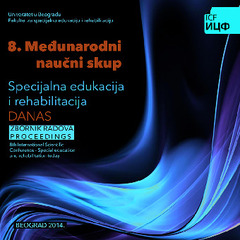Sposobnost produkcije ekspozitornih i argumentativnih tekstova kod desetogodišnjaka
The ability of ten-year-old children to produce expository and persuasive texts
| dc.contributor | Vuković, Mile | |
| dc.contributor | Kovačević, Jasmina | |
| dc.contributor | Maćešić-Petrović, Dragana | |
| dc.creator | Ivanović, Maja | |
| dc.creator | Kašić, Zorka | |
| dc.date.accessioned | 2022-03-22T13:58:40Z | |
| dc.date.available | 2022-03-22T13:58:40Z | |
| dc.date.issued | 2014 | |
| dc.identifier.isbn | 978-86-6203-061-0 | |
| dc.identifier.uri | http://rfasper.fasper.bg.ac.rs/handle/123456789/4260 | |
| dc.description.abstract | Sticanje funkcionalne jezičke pismenosti nije moguće bez uspešnog ovladavanja načelima i principima strukturisanja različitih žanrova zato što različiti tipovi teksta imaju različitu strukturu, funkcije i komunikativne ciljeve. Opservacije pokazuju da u školskom procesu opismenjavanja izostaju neki elementi funkcionalnog opismenjavanja i kod tipične populacije. Osnovni cilj rada bio je da se razmotri u kojoj meri je razvijena i podsticana sposobnost desetogodišnjaka da menjaju komunikativni registar iz kojeg je proistekao i pragmatični cilj kao preporuka na koje elemente treba da se obrati pažnja prilikom usvajanju pisanog jezika kod tipične populacije i kod populacije sa problemima u ovom domenu. U radu se ispituju pojedini aspekti kasnijeg jezičkog razvoja dece u kontekstu pisane produkcije dva različita tipa diskursa – ekspozitornog i argumentativnog. Korpus za analizu sastojao se od 42 ekspozitorna i 42 argumentativna teksta učenika četvrtog razreda jedne beogradske osnovne škole. Tekstovi su analizirani kako u odnosu na kvantitativne parametre (dužina teksta izražena brojem reči, komunikativnih rečenica i klauza), tako i u odnosu na kvalitativna svojstva (prisustvo/odsustvo žanrovskih karakteristika). Kvantitativna i kvalitativna analiza je pokazala karakteristike sposobnosti desetogodišnjaka da produkuju ekspozitorne i argumentativne tekstove. Uočeno je da su desetogodišnjaci u većoj meri sposobni da produkuju ekspozitorni tekst, ali rezultati takođe ukazuju na to da se ova sposobnost još uvek razvija budući da forma, struktura, izbor leksema i sintaksičkih konstrukcija još uvek u većini tekstova predstavljaju glavna obeležja žanra koji su najranije usvojili – narativa. Uvid u razvoj ispitivane sposobnosti kod tipičnih desetogodišnjaka može se koristiti u radu sa decom koja imaju jezičke teškoće i teškoće u usvajanju pisanog izraza. | sr |
| dc.description.abstract | Learning to write well is a necessity for youngsters. Success in school and the fields of employment depend upon it. Students who struggle with writing are at a disadvantage in school, because it is the primary means by which teachers assess students’ content knowledge. Different types of texts are constructed and structured differently, with different writing purposes (communicative goals) and functions. Successful acquisition of basic principles of different text type organization and construction rules is considered to be an essential prerequisite for the development of functional language and communicative literacy.The paper focuses on primary schoolchildren’s knowledge of expository and persuassive genres. Forty-two forth-grade children composed original texts representing each of these genres. All texts were examined for the presence or absence of structural and syntactic features that are typical for these two genres. Different quantitative and qualitative characteristics of texts from the database were taken into account and analyzed: mean length of text measured by number of words, number of utterances, and number of clauses, as well as presence (or absence) of various expository and argumentative genre characteristics.Analysis showed that parpicipants had more experience with expository genre than persuassive one, but also showed that they possessed significantly more working knowledge of narrative genre. Implications of the study highlight the importance of student characteristics in writing achievement, as well as considering the need for differential instruction based on student needs.The paper contributes to theorising genre learning as a complex process of developing both genre and language competence and structure knowledge of these two. | sr |
| dc.language.iso | sr | sr |
| dc.publisher | Univerzitet u Beogradu – Fakultet za specijalnu edukaciju i rehabilitaciju/ University of Belgrade – Faculty of Special Education and Rehabilitation | sr |
| dc.relation | info:eu-repo/grantAgreement/MESTD/Basic Research (BR or ON)/178002/RS// | sr |
| dc.relation | info:eu-repo/grantAgreement/MESTD/Basic Research (BR or ON)/179068/RS// | sr |
| dc.rights | openAccess | sr |
| dc.rights.uri | https://creativecommons.org/licenses/by-sa/4.0/ | |
| dc.source | Zbornik radova - 8. Međunarodni naučni skup „Specijalna edukacija i rehabilitacija danas“, Beograd, Srbija, 7-9. 11. 2014 | sr |
| dc.subject | opismenjavanje | sr |
| dc.subject | strukturisanje različitih žanrova | sr |
| dc.subject | desetogodišnjaci | sr |
| dc.subject | ekspozitorni i argumentativni tekst | sr |
| dc.subject | literacy | sr |
| dc.subject | structuring different genres | sr |
| dc.subject | ten-year-old children | sr |
| dc.subject | expository and argumentative writing | sr |
| dc.title | Sposobnost produkcije ekspozitornih i argumentativnih tekstova kod desetogodišnjaka | sr |
| dc.title | The ability of ten-year-old children to produce expository and persuasive texts | sr |
| dc.type | conferenceObject | sr |
| dc.rights.license | BY-SA | sr |
| dc.citation.epage | 290 | |
| dc.citation.spage | 285 | |
| dc.identifier.fulltext | http://rfasper.fasper.bg.ac.rs/bitstream/id/6686/Untitled32.pdf | |
| dc.identifier.rcub | https://hdl.handle.net/21.15107/rcub_rfasper_4260 | |
| dc.type.version | publishedVersion | sr |


